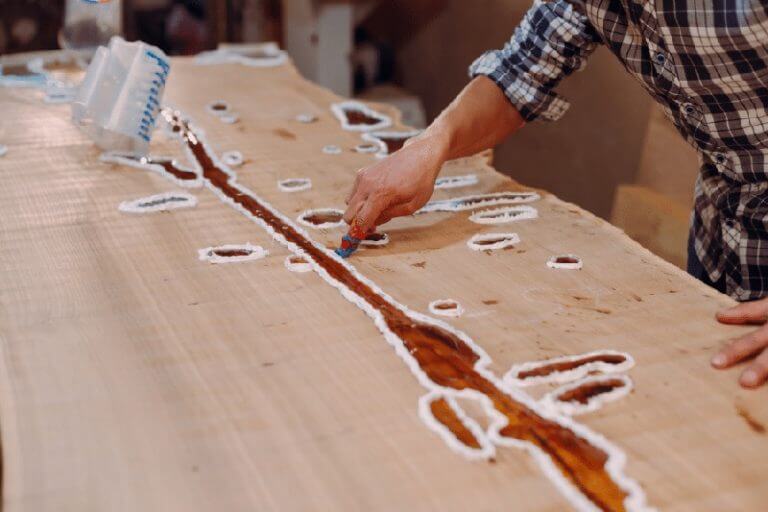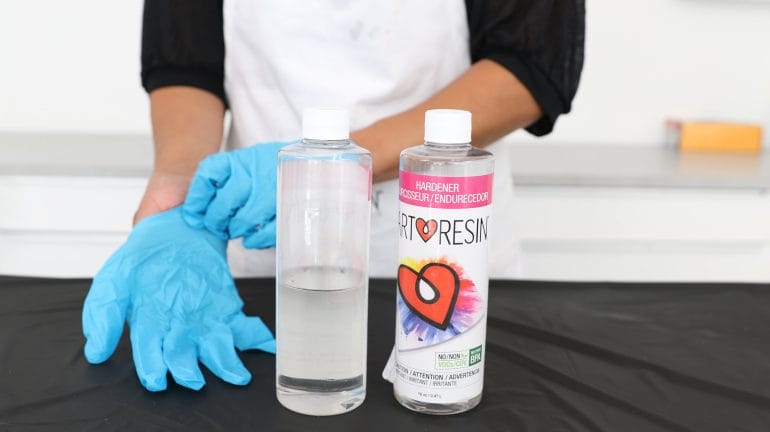Struggling to remove resin from wood surfaces? Look no further! We have the ultimate solution for you.
Resin can be stubborn to remove, but with the right techniques, it can be easily taken off without damaging the wood.

Whether you have gotten resin on your wooden furniture, floors, or any other wooden items, we have curated a step-by-step guide to help you effectively get rid of it.
From using household items to specialized products, we will provide you with simple yet effective methods to ensure a resin-free wood surface in no time.
Read on to discover the best practices and tips to safely and efficiently remove resin from wood, restoring its natural beauty.

Step-by-Step Guide to Removing Resin Stains from Wood
If you have ever worked with resin, you know how messy it can be. Accidental spills or drips on wooden surfaces can leave behind stubborn stains that can be challenging to remove. However, with the right tools and techniques, you can effectively remove resin stains from wood. In this section, we will provide you with a step-by-step guide to help you tackle this task.
Materials You Will Need:
- Protective gloves
- Plastic scraper
- Isopropyl alcohol
- Soft cloth or sponge
- Fine-grit sandpaper
- Wood cleaner or mild soap
- Water
Step 1: Prepare the Area
Before you begin the resin stain removal process, make sure to protect the surrounding area. Lay down a plastic sheet or some old newspapers to prevent any damage to the floor or other surfaces.
Step 2: Put on Protective Gloves
To protect your hands from any chemicals or solvents you will be using in the process, put on a pair of protective gloves. This will also help prevent any accidental skin irritation.
Step 3: Scrape off Excess Resin
Using a plastic scraper, gently scrape off any excess resin from the wood surface. Be careful not to scratch or damage the wood while doing this.
Step 4: Apply Isopropyl Alcohol
Take a soft cloth or sponge and soak it in isopropyl alcohol. Dab the stained area with the cloth, applying gentle pressure. The alcohol will help dissolve and loosen the resin stain.
Step 5: Let it Sit
Allow the isopropyl alcohol to sit on the stained area for a few minutes. This will give it time to penetrate the resin and make it easier to remove.
Step 6: Gently Scrub
Using the soaked cloth or sponge, gently scrub the stained area in a circular motion. Apply more alcohol if necessary. Continue this process until the resin stain starts to lift off the wood.
Step 7: Rinse the Area
Once the resin stain has been removed, rinse the area with clean water to remove any remaining residue or alcohol. Make sure to dry the surface thoroughly.
Step 8: Sand the Surface
If there are any residual stains or marks left on the wood, you can use fine-grit sandpaper to gently sand the surface. Be cautious and only sand the stained area, blending it with the surrounding wood.
Step 9: Clean the Wood
After sanding, clean the wood using a wood cleaner or mild soap mixed with water. This will help remove any sanding residue and restore the natural shine of the wood.
Step 10: Apply Wood Finish
To protect the wood and enhance its appearance, apply a layer of wood finish or polish. Follow the manufacturer’s instructions for the specific product you are using.
Step 11: Regular Maintenance
To prevent future resin stains, it is essential to practice regular maintenance. Clean up spills and drips immediately, and avoid placing resin items directly on wooden surfaces without proper protection.
Summary
Resin stains on wood can be unsightly, but with the right approach, you can effectively remove them. By following this step-by-step guide and using the appropriate materials, you can restore the beauty of your wooden surfaces. Remember to work carefully and take necessary precautions to avoid any damage to the wood. With a little effort and patience, your wood will be free from resin stains and look as good as new.

Top DIY Methods for Getting Resin Off Wood
Resin is a sticky substance that can often find its way onto wood surfaces, leaving behind an unsightly and stubborn residue. Whether you accidentally spilled resin or it has accumulated over time, removing it from wood can be a challenge. Fortunately, there are several DIY methods you can try to effectively remove resin from wood surfaces. In this section, we will discuss the top DIY methods for getting resin off wood.
1. Using Heat
One of the most common and effective methods for removing resin from wood is by using heat. Heat helps to soften the resin, making it easier to scrape off. Here’s how you can do it:
- Carefully heat the resin using a heat gun or hairdryer on a low heat setting. Be cautious not to use excessive heat, as it can damage the wood.
- Once the resin becomes soft, gently scrape it off using a plastic scraper or a credit card. Avoid using sharp objects that can scratch the wood surface.
- If residue is left behind, repeat the process until the wood surface is resin-free.
2. Freezing the Resin
Another effective method for removing resin from wood is by freezing it. Freezing the resin hardens it, making it easier to break off. Follow these steps:
- Place a bag of ice or a freezer pack on top of the resin spot and leave it for a few hours to freeze the resin.
- Once the resin is frozen, gently scrape it off using a plastic scraper or a credit card. Again, avoid using sharp objects that can damage the wood.
- If necessary, repeat the process until the resin is completely removed.
3. Using Solvents
If the above methods do not work, you can try using solvents to dissolve the resin. Here’s what you can do:
- Choose a solvent that is safe to use on wood, such as rubbing alcohol or acetone.
- Dampen a clean cloth or cotton ball with the solvent and gently rub it over the resin-covered area.
- Allow the solvent to sit on the resin for a few minutes to soften it.
- Using a plastic scraper or a credit card, carefully scrape off the softened resin.
- Wipe the wood surface with a clean cloth to remove any residue.
4. Sanding the Wood
If the resin has penetrated the wood or if you are dealing with a large resin spill, sanding may be the best option. Here’s how you can do it:
- Start by using rough-grit sandpaper to sand off the resin. Apply even pressure and work in the direction of the wood grain.
- Once the resin is removed, switch to a finer-grit sandpaper to smooth out the sanded area.
- Finish by applying a wood finish or varnish to restore the wood’s appearance.
In summary, removing resin from wood can be challenging, but with the right DIY methods, it is possible to restore your wood surfaces to their original condition. Whether it’s using heat, freezing, solvents, or sanding, each method has its advantages and is suitable for different scenarios. Remember to take precautions to avoid damaging the wood and test any solvents on a small, inconspicuous area first. With patience and persistence, you can successfully get resin off wood surfaces.

Quick and Easy Solutions to Remove Resin from Wood
If you have ever worked with wood, you may have encountered the stubborn problem of resin stains. Resin can be a real headache to remove, leaving unsightly marks on your wooden surfaces. But fret not, as we have compiled a list of quick and easy solutions to help you tackle this issue effectively.
1. Rubbing Alcohol
Rubbing alcohol is an excellent solvent that can effectively break down resin stains. Begin by dampening a clean cloth with rubbing alcohol and gently dabbing it onto the affected area. Allow the alcohol to sit on the stain for a few minutes to soften the resin. Then, using a clean cloth or sponge, gently rub the stained area in a circular motion. Rinse the surface with warm water and dry it thoroughly.
2. White Vinegar
White vinegar is another powerful natural remedy for removing resin from wood. Mix equal parts of white vinegar and water in a spray bottle. Spray the mixture onto the resin stain and let it sit for a few minutes. The acidity of the vinegar helps break down the resin, making it easier to remove. Afterward, use a soft cloth or sponge to wipe away the stain. Rinse the area with water and dry it well.
3. Baking Soda
Baking soda is a versatile household ingredient that can also aid in resin removal. Create a paste by mixing baking soda with a small amount of water. Apply the paste onto the resin stain and gently scrub it using a soft brush or cloth. Let the paste sit for a few minutes to penetrate the resin before wiping it away with a clean cloth. Rinse the wood surface and dry it thoroughly.
4. Citrus Peel or Lemon Juice
The natural oils found in citrus peels or lemon juice can be effective in breaking down resin stains. Rub the affected area with a piece of citrus peel or apply a few drops of lemon juice directly onto the stain. Let it sit for a few minutes to allow the oils to work their magic. Then, using a cloth or sponge, gently scrub away the resin. Rinse the surface with water and dry it well.
5. Commercial Resin Removers
If the aforementioned solutions do not yield satisfactory results, you can opt for commercial resin removers available in the market. Follow the instructions provided on the product’s packaging for the best results. These removers are specially formulated to dissolve resin stains effectively.
Prevention Tips
Prevention is always better than dealing with resin stains. Here are a few tips to help you avoid resin buildup on your wood surfaces:
- Apply a protective finish or sealant to your wooden objects or furniture to create a barrier against resin.
- Clean spills and remove resin promptly to prevent it from hardening and becoming more challenging to remove.
- Regularly dust and clean your wooden surfaces to prevent resin from accumulating over time.
- Avoid placing hot objects directly onto wood surfaces, as heat can cause resin to melt and leave stains.
In summary, resin stains on wood can be frustrating, but with the right solutions and preventive measures, you can keep your wooden surfaces looking clean and beautiful. Whether you choose natural remedies or commercial resin removers, make sure to test them on a small, inconspicuous area first to ensure they do not damage the wood. With a little patience and the right approach, you can effectively remove resin from wood and restore its natural beauty.
Proven Techniques to Safely Remove Resin Residue from Wood
If you have ever worked with wood, you may have encountered the stubborn problem of resin residue. This sticky substance can be quite difficult to remove, leaving unsightly stains on the surface of the wood. However, with the right techniques, you can safely and effectively get rid of resin residue from wood without causing any damage. In this section, we will explore some proven methods to tackle this issue.
1. Using Isopropyl Alcohol
Isopropyl alcohol, also known as rubbing alcohol, is a versatile solvent that can be used to dissolve resin residue from wood. It is important to note that isopropyl alcohol should only be used on finished, sealed wood surfaces. Here’s how you can use it:
- Dampen a cloth with isopropyl alcohol.
- Gently rub the cloth over the resin residue, applying light pressure.
- Continue to rub until the resin begins to dissolve and lift off the wood surface.
- Once the resin is removed, wipe the area with a clean, damp cloth to remove any remaining residue.
- Dry the wood thoroughly.
2. Applying Heat
Another effective method to remove resin residue from wood is by using heat. Heat helps soften the resin, making it easier to scrape off. Follow these steps:
- Use a hairdryer or heat gun to apply heat directly to the resin residue.
- Keep the heat source at a safe distance to avoid burning or damaging the wood.
- As the resin softens, gently scrape it off using a plastic scraper or a credit card. Be careful not to scratch the wood surface.
- Continue heating and scraping until all the resin is removed.
- Clean the area with a mild soap and water solution to remove any remaining residue.
3. Utilizing Citrus Solvents
Citrus solvents, such as orange oil or lemon oil, are natural alternatives that are effective in breaking down resin residue. Here’s how you can use citrus solvents:
- Apply a small amount of citrus solvent directly to the resin residue.
- Let it sit for a few minutes to allow the solvent to penetrate the resin.
- Gently scrub the area with a soft brush or cloth to loosen the resin.
- Wipe away the dissolved resin with a clean, damp cloth.
- Rinse the wood with water and dry it thoroughly.
4. Using Mineral Spirits
Mineral spirits, also known as white spirit, can be effective in removing resin residue from wood. Follow these steps:
- Dampen a cloth with mineral spirits.
- Gently rub the cloth over the resin residue, applying light pressure.
- Continue to rub until the resin starts to dissolve and lift off the wood surface.
- Once the resin is removed, wipe the area with a clean, damp cloth to remove any remaining residue.
- Dry the wood thoroughly.
5. Sanding the Resin
If the resin residue is deeply embedded in the wood, sanding may be the best option. Here’s how to do it:
- Start with a coarse-grit sandpaper and gradually move to finer grits.
- Sand the resin residue in a circular motion, applying even pressure.
- Continue sanding until the resin is completely removed and the wood surface is smooth.
- Clean the area thoroughly to remove any sanding dust.
These proven techniques can help you safely and effectively remove resin residue from wood surfaces. Remember to test any product or method on a small, inconspicuous area first to ensure it doesn’t cause any damage to the wood. By following these methods, you can restore the natural beauty of your wood and eliminate the unsightly resin stains.
FAQs
How can I remove resin from wood?
To remove resin from wood, you can apply a generous amount of rubbing alcohol or acetone to a clean cloth and gently rub the affected area. Alternatively, you can use a heat source like a hairdryer to soften the resin and then scrape it off with a plastic tool. Remember to test these methods on a small, inconspicuous area first.
Can I use a chemical cleaner to remove resin from wood?
Yes, you can use a chemical cleaner specifically designed for removing resin from wood. Look for products that contain ingredients like mineral spirits or denatured alcohol. Follow the instructions on the cleaner and ensure proper ventilation when using these products.
Will removing resin damage the wood surface?
When done correctly, removing resin from wood should not cause any damage to the surface. However, it’s always a good idea to test any cleaning method on a small, hidden area first to ensure it doesn’t have any adverse effects on the wood finish.
Conclusion
In conclusion, removing resin from wood can be a daunting task, but with the right techniques and tools, it is entirely possible to restore the natural beauty of your wooden surfaces. Whether you are dealing with small resin stains or larger spills, remember to act quickly to prevent the resin from permanently bonding with the wood. Utilizing methods such as scraping, heat application, and solvents can effectively dissolve and remove the resin. However, always exercise caution and test any products on a small, inconspicuous area of the wood before proceeding. With patience and persistence, you can successfully eliminate resin and bring back the original charm of your wooden furniture or flooring.
